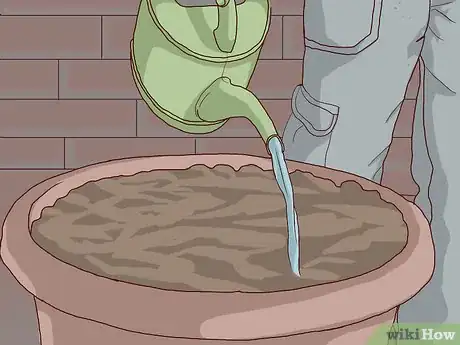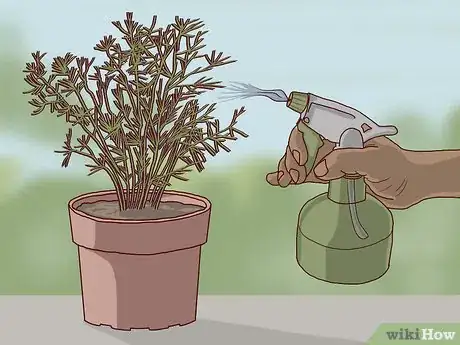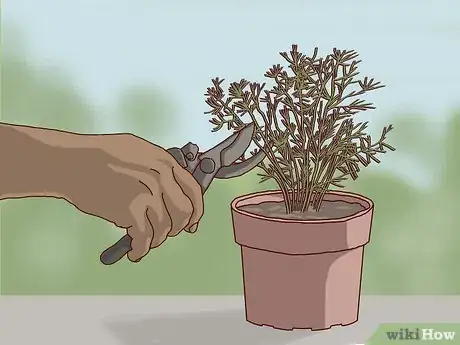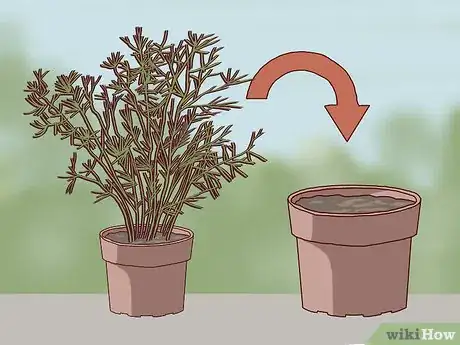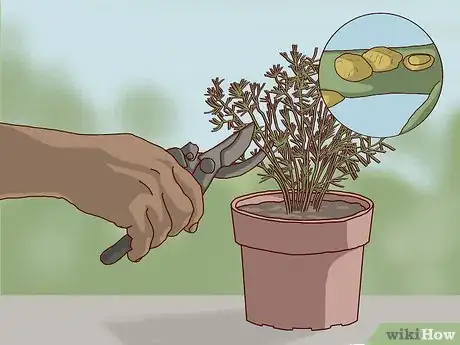This article was co-authored by Mark Leahy. Mark Leahy is a Plant Specialist based in the San Francisco Bay Area. He is the Co-Owner of Bella Fiora, a custom design floral studio, and SF Plants, a plant shop and nursery. Mark specializes in floral artistry and indoor plants including floral arrangements, terrace planters, office plantscapes, and living walls. Mark and his business partner have been featured in Vogue, The Knot, Today’s Bride, Wedding Wire, Modern Luxury, San Francisco Bride Magazine, San Francisco Fall Antique Show, Black Bride, Best of the Bay Area A-List, and Borrowed & Blue.
There are 10 references cited in this article, which can be found at the bottom of the page.
wikiHow marks an article as reader-approved once it receives enough positive feedback. This article received 13 testimonials and 94% of readers who voted found it helpful, earning it our reader-approved status.
This article has been viewed 375,637 times.
The asparagus fern (Asparagus sprengeri) is a common and fast-growing houseplant. It's called a fern, but is actually a member of the lily family. It has fine needle-like leaves and arching stems that can grow up to three feet long. Mature ferns sprout white or pink flowers and grow green, inedible berries. To properly take care of an asparagus fern, you should create the right environment, propagate the plant, and maintain it regularly.[1]
Steps
Preparing the Right Environment
-
1Choose a location. Asparagus ferns can be indoor or outdoor plants. It is your choice to plant them in a pot, hang them outside, or plant them directly in the ground. Make sure that you choose an open space that allows room for the plant to grow.[2]
- Place it in a space that allows 4 feet of height and 3 feet of width to grow.
- Ferns like some fresh air, so keep that in mind when you're choosing the location.[3]
- Think carefully about the location because transitioning the plant from indoors to outdoors can be traumatic for it. If you do choose to change the location, gradually transition the plant during a course of two to three weeks. Start by moving it into a shaded area, like in a patio or under a tree. Then, move it into a place that receives more sunlight until eventually moving it into your chosen spot indoors.[4]
-
2Search for a location with a moderate temperature. This plant needs daytime temperatures around 50 to 75ºF (around 10ºC-24ºC). Night temperatures are best around 50 to 65ºF (10-18ºC). Choose a spot that maintains an average room temperature.[5]
- Asparagus ferns can grow in places with moist or dry air, but they do best in a place with moist air.
- To assure moist air, you can place a humidifier in a room adjacent to the room the fern is placed in.[6]
Advertisement -
3Pick a place with good lighting. This plant will grow best in a place that has bright, but indirect lighting. It should not be placed fully in the sun.[7] Too much direct sunlight will cause the needles to scorch and drop off of the plant.[8]
- You will know that the fern is receiving too little sunlight if it the needles turn yellow.
- Plant it in a place that benefits from the morning sun.
-
4Find a slightly acidic soil. Asparagus ferns do best in soil that is rich, light, and slightly acidic. The soil should also be well-drained. Add peat moss to your soil or buy a peat moss planting mix. Peat moss is the partially decomposed remains of several types of mosses that contribute to the right soil condition for your fern.[9]
- Your soil is well-drained if water percolates through it easily. You can check this by digging a hole in your soil, filling it with water, and allowing it to drain. Your soil is well-drained if the water drops from 1 to 6 inches an hour.[10]
Growing the Plant
-
1Propagate the plant. You can grow it from seed or by root division. If growing from seed, plant the seeds ½ inch deep in the container, and leave it on a warm, sunlit windowsill for about four weeks. Propagating by division, however, is the quickest and easiest method, and should be done in the early spring.[11]
- For propagation by division, you can slice the root ball into half or quarter sections with a knife and repot into separate, smaller planters. It is also an option to pull the tubers apart by hand. Pulling the tubers apart by hand allows you to separate the tubers in a more natural direction than by using scissors. The tubers will need to be repotted into separate planters.
- You can separate the good and bad seeds by putting them in a bucket full of water and leaving them for a few days. The bad seeds will float to the top, and the good seeds will sink to the bottom.[12]
-
2Plant the seeds. With the proper and chosen conditions in mind, plant your seeds in a pot, or in the ground. To plant, dig a hole in the soil that is twice the length of the seeds you’re planting. Then, cover the seeds with a light layer of soil. You will not need to worry about planting and watering the seeds if you chose to plant the tubers instead of seeds.[13]
- For example, plant seeds that are 1/8th of an inch in 1/4th soil.
-
3Water the seeds. You will need to thoroughly water the seeds directly after planting. The plant should start growing from the seedlings within a week or two. During this time, you should be constantly watering your seedlings. You should water the seeds every time the ground is dry.
- If you planted the tubers, you will still need to water them directly after planting. Water them once a day and every time the ground is dry.
- In hot weather, you may need to water twice a day.[14]
Maintaining Your Fern
-
1Fertilize your asparagus fern. You should purchase a soluble (liquid), all-purpose fertilizer. Make sure to dilute the fertilizer to ½ strength. During the period of growth, March to August, you will need to fertilize every three to four weeks. After that, fertilizing monthly should be adequate.[15]
- Water soluble fertilizers typically come in liquid or powder form. Powder fertilizers need to be mixed with water. To use, you need a watering can or hose-end sprayer. Spray or pour the fertilizer until the soil is saturated, but not drowned in water.
-
2Water the plant regularly. Once the seedlings grow into a plant you will need to continue watering the plant regularly. Asparagus ferns can survive during periods of drought, but you should continue to water it every time the soil is dry. During the winter, you should water the plant less.[16]
- You can water the plant once a week during the winter. The heat during the summer causes the ground to become dryer faster. The soil does not dry out as quickly during the winter. You should water more than once a week if you live in a climate that is hot or warm during the winter.
- Before watering, allow 50 percent of the soil to dry out and watch for the fronds to turn a light green. Yellow fronds indicate that the plant is getting too little water and brown fronds indicate that it is getting too much water.
- Ferns like to be watered thoroughly—one way you can do this is to lift up the leaves and dunk the whole pot into a basin of water until you see the bubbles stop. Do this every 5 days or so, spritzing them lightly in between waterings.[17]
-
3Prune the plant. Pruning allows new growth, and it keeps your plant neat. You should trim old stems every spring. Old or dead stems will appear dry, withered, and they will no longer produce growth. Trim any stems or growth that sticks out too much, or appears dry or dead. Make sure to wear gloves while you prune to avoid being scratched by the “needles” on the fern.
- Scissors or hand pruners will work fine. You do not need anything bigger.
- At this point, the plant will be sprouting white flowers and red berries. Be aware that the red berries that accompany the blooms are poisonous! Do not eat them!
-
4Repot during the spring. If you planted your fern in a pot, you will need to repot it once a year in the spring. Move your plant to a pot that is only one size larger. Ferns grow rapidly, and repotting allows them to grow freely and without damage.[18]
- You can repot more than once a year if your fern is spilling over the pot it is currently in.
- The roots of the fern can sometimes push the soil to the top of the pot. Keep your soil 1 to 2 inches from the rim of the pot.
-
5Deal with pest problems. Asparagus ferns rarely have problems with major insects or diseases that can cause them to die, so you should not have to spray them. You should use insecticide soap on them rather than insecticide. Ferns sometimes become infested by spider mites, scale insects, and mealy bugs. However, this is only a problem if you are transferring the fern from outdoors to indoors.
- Inspect your ferns before transporting them from indoors to outdoors. If the infestation is too much, you can trim the stems back to the soil line. New stems will grow back.[19]
- Trimming the branches should solve the insect problem. Try to avoid a spray if possible. Sprays will kill both beneficial and harmful insects.
Expert Q&A
Did you know you can get expert answers for this article?
Unlock expert answers by supporting wikiHow
-
QuestionCan an asparagus fern survive winter?
 Maggie MoranMaggie Moran is a Professional Gardener in Pennsylvania.
Maggie MoranMaggie Moran is a Professional Gardener in Pennsylvania.
Home & Garden Specialist
-
QuestionHow much sun does an asparagus fern need?
 Maggie MoranMaggie Moran is a Professional Gardener in Pennsylvania.
Maggie MoranMaggie Moran is a Professional Gardener in Pennsylvania.
Home & Garden Specialist
-
QuestionHow often do you water an asparagus fern?
 Maggie MoranMaggie Moran is a Professional Gardener in Pennsylvania.
Maggie MoranMaggie Moran is a Professional Gardener in Pennsylvania.
Home & Garden Specialist
Warnings
- This plant takes well and grows fast. As such, it has weed potential and has been declared a weed in Florida, Hawaii, and New Zealand. Keep it under control.⧼thumbs_response⧽
- The fern may cause a skin rash. Be careful when handling it, and use gloves as much as possible.⧼thumbs_response⧽
- The asparagus fern grows thorns. Wear gloves when handling the thorns and needles.⧼thumbs_response⧽
- Keep this fern away from pets and children. It is poisonous for them to ingest.⧼thumbs_response⧽
References
- ↑ http://www.guide-to-houseplants.com/asparagus-fern.html
- ↑ http://www.thegardenhelper.com/asparagus_ferns.html
- ↑ Mark Leahy. Plant Specialist. Expert Interview. 11 December 2020.
- ↑ http://www.thegardenhelper.com/asparagus_ferns.html
- ↑ http://www.guide-to-houseplants.com/asparagus-fern.html
- ↑ http://pss.uvm.edu/ppp/articles/fernsin.html
- ↑ Mark Leahy. Plant Specialist. Expert Interview. 11 December 2020.
- ↑ http://www.thegardenhelper.com/asparagus_ferns.html
- ↑ http://www.thegardenhelper.com/asparagus_ferns.html
- ↑ http://www.rodalesorganiclife.com/garden/what-the-heck-does-well-drained-soil-actually-mean
- ↑ http://www.thegardenhelper.com/asparagus_ferns.html
- ↑ http://freeplants.com/growingfrmseed.htm
- ↑ http://freeplants.com/growingfrmseed.htm
- ↑ https://www.planetnatural.com/organic-gardening-guru/planting/
- ↑ http://www.thegardenhelper.com/asparagus_ferns.html
- ↑ http://www.thegardenhelper.com/asparagus_ferns.html
- ↑ Mark Leahy. Plant Specialist. Expert Interview. 11 December 2020.
- ↑ http://www.guide-to-houseplants.com/asparagus-fern.html
- ↑ http://www.thegardenhelper.com/asparagus_ferns.html
About This Article
To care for an asparagus fern, place it in a location that where it can grow at least 4 high and 3 feet wide. This spot should be between 50 to 75ºF and get sunlight in the mornings. Fertilize your plant every 3-4 weeks between March and November and water your fern 1-2 times a week, or whenever the soil feels dry to the touch. To propagate an apsaragus fern, you can slice the root ball into half or quarter sections with a knife and repot the sections of root ball into a few different planters. For advice from our Horticulturist reviewer about what soil and fertilizer to use, keep reading!







